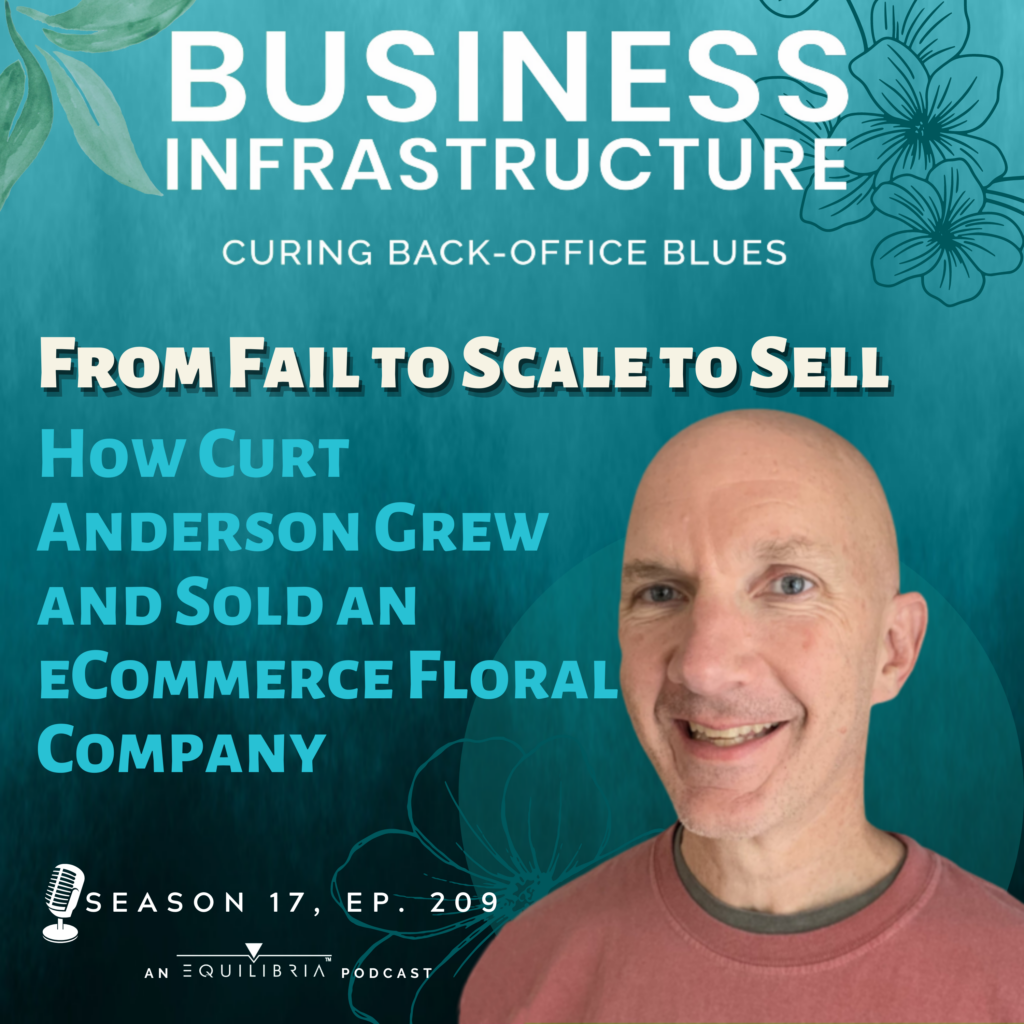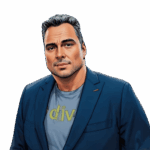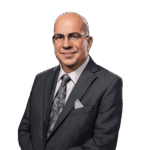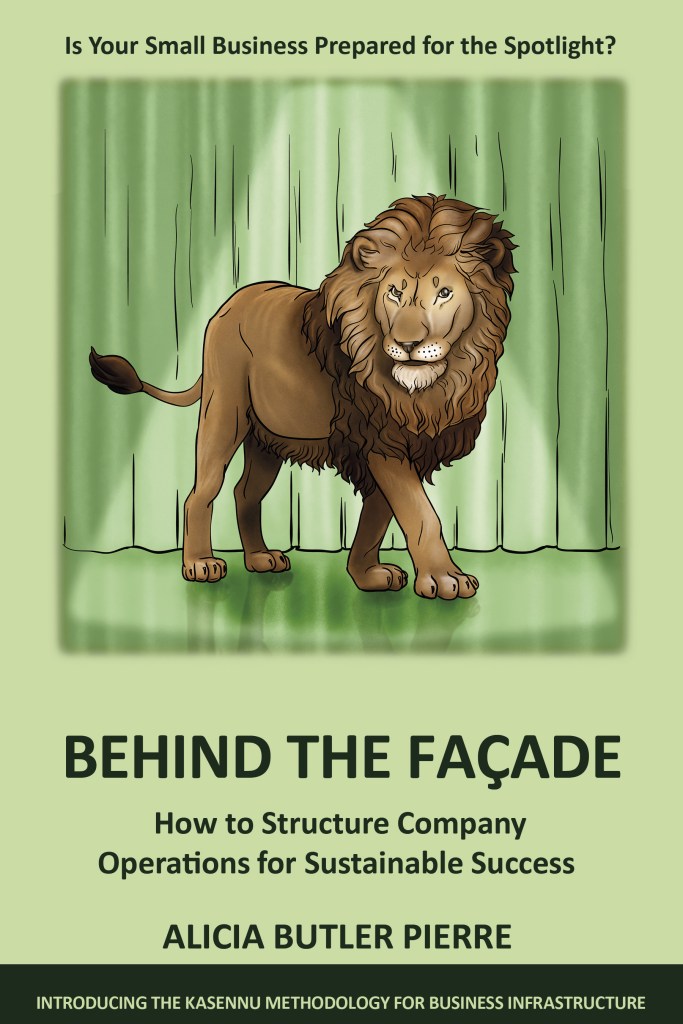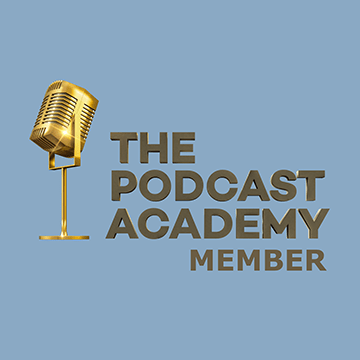Transcript
Hey there! How are you? I’ve missed you! For the first time in six months, we’re back with 12 entrepreneurs who are guaranteed to motivate and inspire you to take action in building your business infrastructure. They’re each going to share a scale tale – a firsthand account of that magical moment when consistent, quality work intersected with the ability to increase output without increasing costs.
That’s what’s coming up here on Season 17 of the Business Infrastructure podcast where we give you access to resources for curing your back-office blues and transforming your operations. I’m Alicia Butler Pierre, creator of this show and your guide through this season.
First up to share his scale tale is Curt Anderson, a proud GirlDad and self-proclaimed eCommerce evangelist for manufacturers and who’s on a mission to help you reach your eCommerce goals as quickly and painlessly as possible.
This is Ep. 209: From Fail to Scale to Sell – How Curt Anderson Grew and Sold an e-Commerce Floral Company
____________

This episode is brought to you by Equilibria, Inc. the company behind this podcast where we design scale-ready business infrastructure for fast-growing small businesses.
____________
Running a small business is hard work. There’s no doubt about it. But the dynamics of running a family-owned business can be even more challenging. What would you do if no matter how hard you tried, you just can’t seem to break through to sustainable profitability? And to make matters worse, your accountant describes you as a train wreck? Would you fold or would you rise to the occasion to prove everyone wrong? Here’s Curt’s story of the time he scaled a wholesale floral business.

Curt Anderson here, I’m coming to you live from little tiny, beautiful, wonderful Lakewood, New York. It’s a small lake community in upstate New York. My entrepreneurial journey started in 1990. So I’m an older dude. And, I graduated from college in June of 1990 on a Friday. And on that following Monday, I took over a bankrupt defunct family business. And so at that time, a very tight-knit close family and, my father had a business and unfortunately, he was ill and a business, became in deep financial trouble. And so three days after graduation, I took over that company.
Although Curt had big plans after graduating, he soon found out that life had other plans.
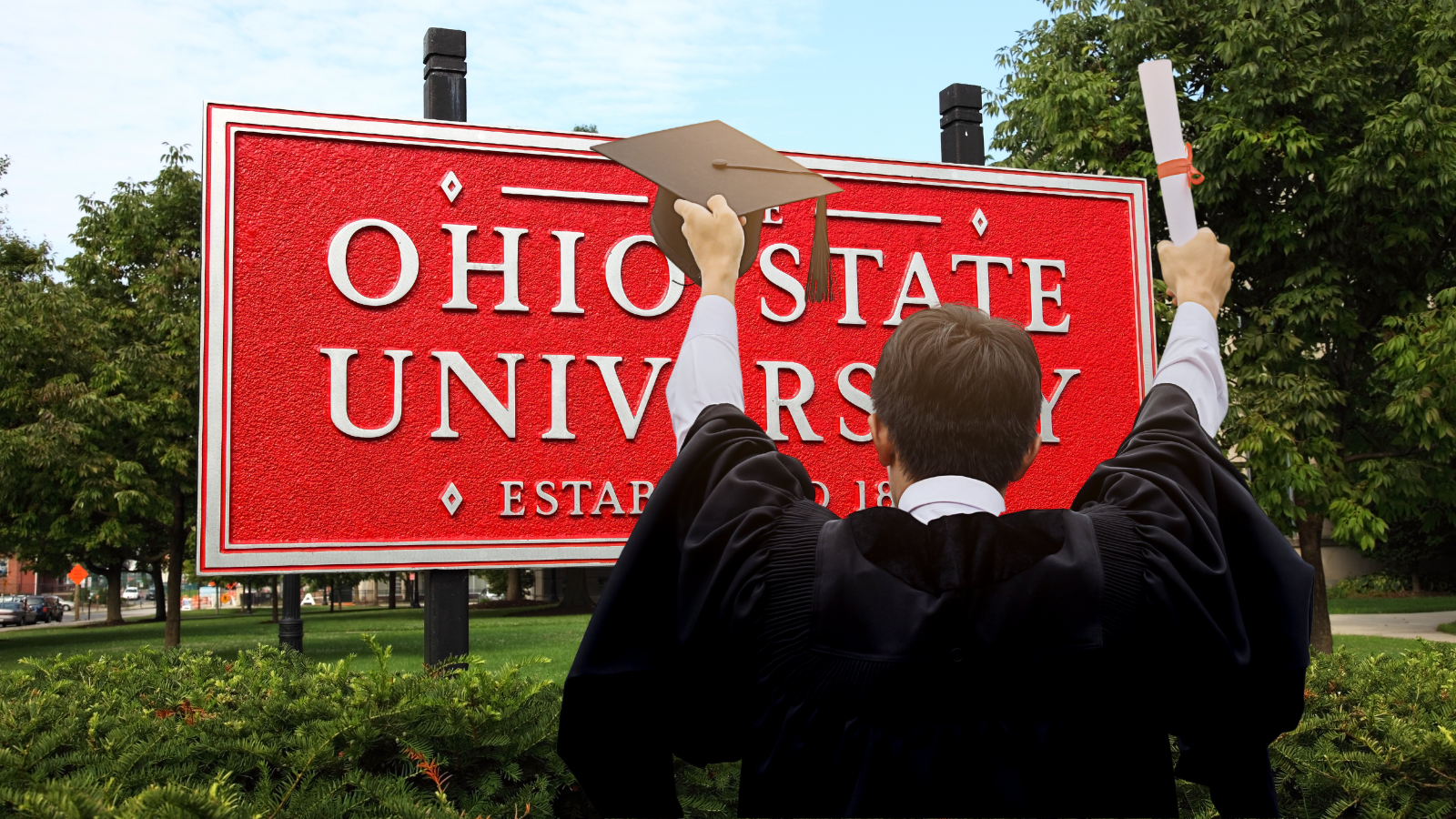
I went to Ohio state university and was going to go off and conquer the world and do all sorts of fun, exciting things, maybe Europe, maybe this, that, the other thing, I was very, very tight with my father.
And he asked me for help. And so I decided to help him out with his business. I didn’t take that class in college of, how to recover a bankrupt family business. That one, not that one that class passed me by. So it was literally 21 years old learning on the fly. It was a wholesale business and we had all sorts of challenges, struggles. I don’t know as if I would do it again, but boy, it was, certainly, learn. Was it learned, fueled by fire or I don’t know, learn, learn on the fly, whatever it was. And so, that’s how, that was how I kick-started my entrepreneurial journey, kind of always knew I wanted to get into business. Just didn’t expect that route. when I got into that wholesale business, boy, we just, we didn’t have a lot of options and it was a struggle and it was, it was extremely challenging.
Challenging because, as Curt describes…more trouble was on the horizon.
It was a wholesale floral business. We supplied like flower shops, grocery stores, craft, that type of thing. Wholesale at that time in the early nineties was just getting pinched in all directions. You know, the supply chain was, you know, all over the board where importers and manufacturers are starting to sell direct to either retailers, wholesalers were starting to sell direct to consumers. In the early nineties, there was a lot of rolling up. So this is when a big brick-and-mortar stores were really catapulting, at that time.

So a lot of the mom-and-pop businesses were really vanishing during the nineties. I had a location in a small community and then I’m near Buffalo. So I had a, a wholesale business in Buffalo, New York and another one, near where I’m at now. And so the thing is, it was very difficult, very challenging running two operations, you know, the time now. I’m probably like in my mid-twenties, we’re starting to get a little bit of momentum. We’re getting past some of those, you know, severe financial challenges. But unfortunately, Alicia, I do have to say this, my accountant that I had at the time said that I was the biggest train wreck that she had ever met. I don’t know.
Curt can laugh about it now, but I’m sure being called a train wreck had to hurt. But lucky for him, his first lifeline was on the way from what at the time seemed an unlikely source.

I take that with a badge of honor, boy, you know, if you’re going to be good at something, you might as well be just great at it. I was great at being a train wreck. And so she shared with me, she goes, I was the biggest train wreck that she had ever encountered. So this is like 1995. And at the time, for those of us that were around, there was this thing that was really starting to pick up and it was called the internet. And like America online was doing like their first Superbowl ads and they were sending out like these little CDs, if anybody who was old enough to remember the CDs that were going out to get you on the internet and 14.4 modem dial-ups and all this fun thing. And I sat there at that time in 1995, I’m like, man, my accountant’s telling me I’m a train wreck.
From fail to scale to sell in just under 20 years. How on Earth did Curt do it? Well, it turns out he had some other lifelines. He’ll share exactly how business infrastructure saved the day after the break.
____________
You started your business because you believed you could make a difference. But now you have more demand than you can keep up with and if you don’t get your operations in order soon, you could lose everything you’ve worked so hard to build. The chaos is causing angry customers, bad reviews, failed audits, and more. The need for a unified team with processes they can follow and tools they can use without your presence is apparent. Where can you go for support?

That’s where The Smooth Operator masterclass can help. It’s an on-demand, online course that not only teaches you what business infrastructure is, but also shows you how to create it through video demonstrations and access to a private community where you can get more support. Build a foundation for operational success with a scale-ready framework that’s tried, tested and true. Sign up today at SmoothOperator.courses. That’s SmoothOperator.courses.
____________
We’re back and before the break, Curt Anderson gave a short recount of how he scaled and sold his company. But how did he do it? Turns out business infrastructure, a system for linking people, processes, and tools to create a foundation for sustainable scale, was his next critical lifeline.
I’m running out of options. I have tried everything to get this business to be successful. I’m going to try this whole e-commerce thing that people are talking about and this whole internet thing. Let’s see if this would work. And so I put the business online and we converted it into an e-commerce business. And boy, it took, it took a long, really long time, but finally, this, this little company called Google came on the scene. And if you were on e-commerce and if you survive the whole dotcom bust in 1999, 2000, and you know, you jumped on Google and then all of a sudden, social media was starting to come around on Facebook in 2003, LinkedIn, YouTube in 2006 or so Twitter. And, we had, we finally, finally eventually had a really nice run with our e-commerce.

We converted into an e-commerce company. There’s a magazine called internet retailer. We were blessed and fortunate we made the top 1000 e-commerce companies three years in a row. Amazon was number one. I was way back in like 7 – 800, but we still made that list. And, I was very fortunate, beyond that, we scaled the business and ended up selling it. I ended up signing and so a great experience, great opportunity, you know, and I’m still in e-commerce today. And so that was my, that was my run. And it took me about, you know, a good 15, almost 20 years, you know, so, I mean, it was a big learning process to finally scale up and try to see, you know, the vision I had to finally get to that finish line if you will.
I’ll start with this, though I was a train wreck, I learned a ton. So, you know, early entrepreneurs out there, boys surround yourself with experts that can take you to the next level. And so that was one of the biggest credits. You know, if I’ll credit myself to anything, it was like building a phenomenal team. So I started in 1990, I finally, built up the business. It was about 2010, you know, through the two thousands we had, you know, we started getting traction, turn the company around and had a really nice run.

With a team in place, just when things were going well with this “nice run,” Curt had an epiphany.
When the words came out of my mouth, “This is how we’ve always done it.” I went home that night and this is the gospel’s truth. I knew I was done. I had been there too long. The day that that came out of my mouth, I knew I was out of fresh ideas, fresh energy. you know, maybe my calling was for a new challenge, whatever it was.
The other second thing that I credit myself with is, is having the wherewithal. And it’s extremely humbling because your business is your baby and when you, you’re raising your child and all of a sudden your child just doesn’t necessarily need you anymore. And it was extremely eye-opening and a powerful experience that not only had the business kind of outgrown me, I thought I finally had the epiphany. I’ve kind of stayed my welcome. And so, I had, I took on, a business partner, who I hired her in 2000, in 2000 and she hands down and, even to this day in my 30 plus career, she hands down was probably the best business decision that I ever made. And we, it was just magic. We built a wonderful company together.
Eventually, his new business partner became the buyer of his family-owned turned e-commerce business.

I hired this person, I was hiring a person and I had met her a few times. And I can tell you exactly where it was. I was with my wife in the night before I said, “You know, I’m hiring, I’m going to hire this person tomorrow.
I wasn’t hiring her to groom her or a successor or anything like that. It was October of 1999. The internet boom, bubble was on the cusp. This was pre-9/11. So I mean, business was, you know, was in a better place in 1999 than a lot of things happened in 2000, like Enron and all those things, 9/11, but, you know, things were just tragic in the country after post 9/11.
And this person that I hired, we just, she was just an integral piece. She is a pit bull. She is a phenomenal, incredible, amazing gifted entrepreneur, gifted business woman. We built up the company together. So prior to selling the company, the business was outgrowing me. We’re in wholesale distributor, with multiple channels that we were selling to, but, you know, it’s, it’s distribution, you know, it’s logistics. And so it was just getting beyond my scope beyond my ability, what we did is we moved the company to a third party fulfillment center.

When we moved the company to a third-party fulfillment center that removed a huge part of my job, of my tasks. You know, that was the whole operations of getting goods out the door. That really a lot of that fall on my plate. Again, another humbling moment of like, Hey, this is outgrowing me. So either I can continue investing into my company with overhead and fixtures and so on and so forth, or I can align myself with a subject matter expert, like a third party fulfillment center, which I did. And so by taking that off of my plate and put it onto the experts, now they could ship goods.
At this point, all the elements (that is, people, processes, and tools) of business infrastructure were in place. He had a team and a business partner who balanced his skillset along with use of the latest e-commerce and internet technologies. By outsourcing logistics processes, Curt freed up his time to focus on promoting and growing the business. In other words, he was now working on his business and not just in it.
Now, all we did is, we became guerrilla marketers. Now we can just laser focus on finance, accounting, you know, marketing social, you know, in 2009, 2010, social media was really starting to blow up.
And so, you know, we went right on YouTube. We went right on Twitter, Facebook. I never wanted to be beat out by my competition because I ignored a new technology, you know, and with social media, you know, back then it was free. I’m like, boy, I don’t know. I don’t know if this whole Twitter thing, that’s 140 characters. Things is going to work, but I don’t want to be beat out by my competitors by ignoring social media or these new platforms. So by partnering with that third-party fulfillment center, we put our entire operation, boy, we were just able to explode from there because it was no longer on my plate.
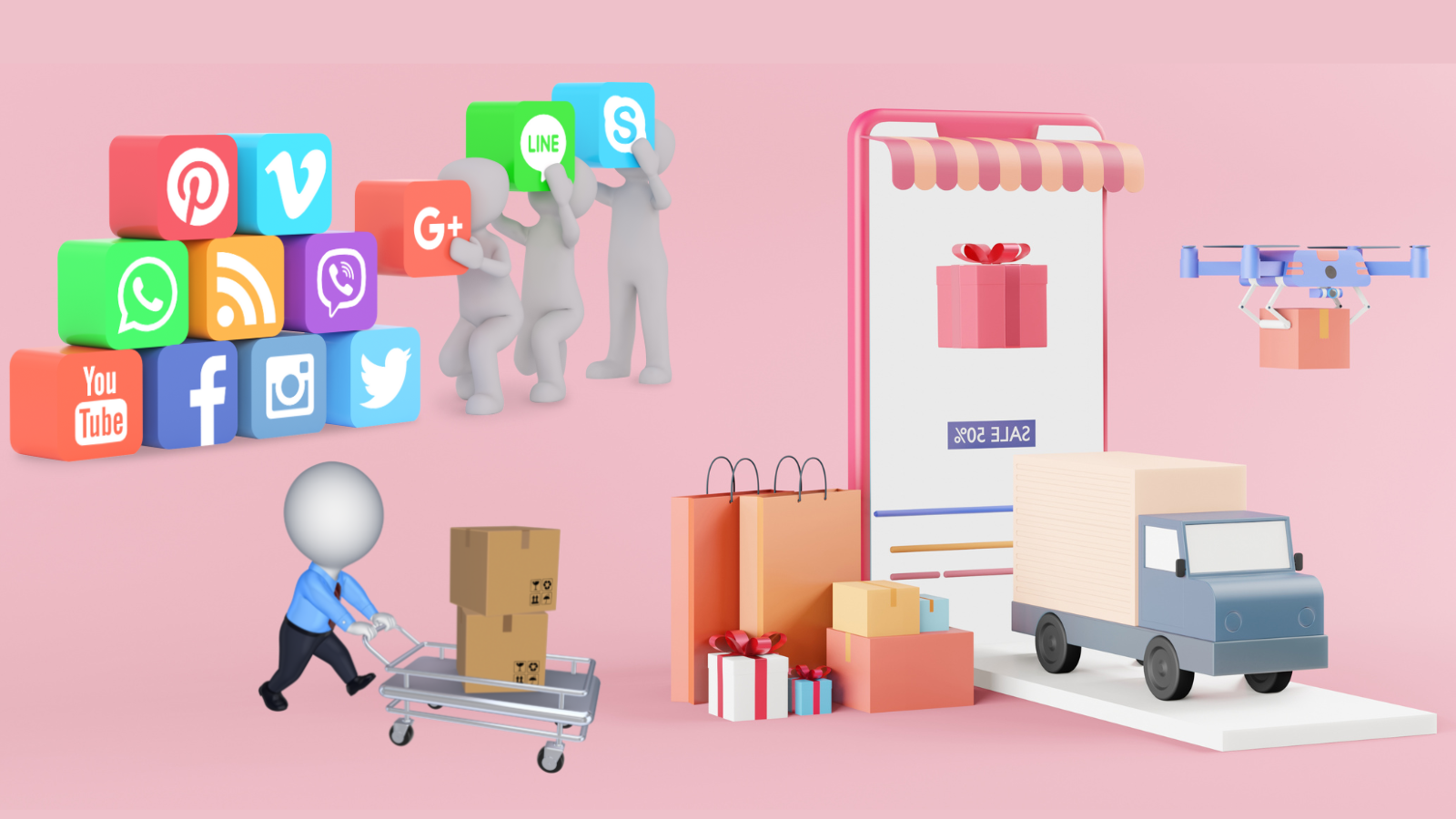
Remember that epiphany Curt mentioned having?
And then eventually on the marketing side, that’s when I had my famous, “This is how we’ve always done it.” And that was my aha moment. And so that was my transition. So that was kind of my, that tenure transition from 2000 to 2010ish, to going to fulfillment center and then finally selling the company.
And when you did in fact decide to sell the company to your business partner, how many people were employed by you by that point Curt, do you remember?
Yeah, what’s funny is so we were small. There was 15 of us, prior to going to the fulfillment center. Here’s a fascinating thing. When I went to the fulfillment center, our sales were significant. I had three employees. We were just so efficient. So compared to where I was in 1995, when I was at train wreck to my account to 2000, it was just, a real nice, well-oiled machine and sales were, you know, significant again, we made that, internet retailer list, three years in a row and it was just profitable, it was a great business.
You know, what I think is interesting about what you said about going from 15 employees down to three, there might be someone who’s listening to that and thinking, well, that sounds like he went in the opposite direction. I would. Thank you. You know, when you scale, you have more employees, but you said something very important and that is that you all outsource to a third-party fulfillment center.
So that’s how you actually achieved the scale because you were able to leverage all of their resources, their, their warehousing, their logistics, their supply chain fulfillment and, and all of those things. So I can’t, I can’t even imagine how many people actually worked in the fulfillment center, but by pairing it down to, from 15 to three people, you could focus even more and, and on the business development and some of the guerrilla marketing tactics that you’ve described.
So I just thought that was worth pointing out because, you know, I was thinking, I bet you there’s someone who’s might listen to this and think, wait a minute, Curt, you went in the opposite direction, but, but you made a very key investment, a very significant investment by outsourcing a key part of the operations. When you realized that you could achieve a level of scale that to your point, if you had to do that completely in-house, it would have been incredibly expensive. I would imagine.
We’ll, we’ll turn it back to you for a second. Had I known you 17 years ago, or so when you started your company, maybe I would have fast-forwarded that, but you are a hundred percent correct. I was in an old, a hundred and some year-old factory building. We had like 10 to 15,000 square feet, very inefficient. It was, you know, multiple floors old, you know, pull pulley, elevator type thing. And, you know, when we moved to the fulfillment center, we moved to a better location geographically to service product faster to our customers.

You know, I think they had like 30,000, 40,000 square feet for our company. And, so when we were busy and we were very seasonal, their staff that was working on other projects, well, it converted my fixed expenses into variable expenses. And so, you know, when his staff was busy with my company, that was great. Well, when, if they’re slower times will then his focus has shifted over to other companies that they were shipping out, if I do all this fulfillment on my own, this is going to be substantial. And it’s going to take those profits out of my pocket again. By converting those into variable expenses and partnering with that third-party logistics company. It just really allowed us to scale. And a company just grew double digits, you know, most consistently year in year out, it was just, it was extremely rewarding.
I must ask, did you keep the same accountant who told you, you were a train wreck? And if so, what was that accountant’s response, seeing the progress that you made over that 20-year period?
We stayed very, very close, very tight. She is, a wonderful, wonderful woman. And, you know, and I’ll share this. I was at a meeting with her and it was in between Christmas and new years of whatever year, 2001, 2002. And, you know, I was having like a big pity party for myself. So I’m sitting with my accountant and her name’s Marsha and Marsha is like, well, you know. Fourth quarter was not our best quarter of the year. And so I’m just, woe is me. Am I complaining about this, complaining about that. And she’s like, well, “Curt, have you tried this?” I’m like, “No.” “Curt, if you tried this” Well. “Hey, what about this?” Well. “Hey, you could save money here. You can make money here.” And I was shooting down every idea that she said to me.
But Marsha wasn’t having it and, not being one to mince her words, gave Curt another dose of unforgettable advice.
She’s a very short in stature but packs a powerful punch. She scoots up in her chair. She looks at me dead in the eye. She scoots up in her chair and she looks at me and she goes, “Curt, do you watch Dr. Phil?” I’m like, “Well, yeah, I know Dr. Phil, I don’t watch them.” She goes, “You know what, I watched Dr. Phil, as a matter of fact, I tape this.” Back in the days of when we would tape, “I record Dr. Phil every day. You know why I record Dr. Phil? Because he tells people what they need to hear, not what they want to hear. I just gave you five suggestions to make more money, and you shut down every one of them, your problem is you don’t want to make money!”
Ouch!
I thank God for Marsha, that she had the courage to call me out. And boy, we turned things around and never looked back from that moment on. So, you know, take that hard advice, align yourself with people that don’t tell you what you want to hear. I love that constructive criticism. That’s the only way that you can grow.
What does life look like for Curt after selling his business? I wanted to know because it’s rare that an entrepreneur in this position doesn’t start another business.
After I sold my company, what I found my interest, passion, helping other companies, trying to figure out this whole e-commerce thing in particularly manufacturers. And why manufacturers? Because I’m a digital immigrant, I’m in my fifties and a lot of manufacturers are older folks like myself and, you know, e-commerce or digital marketing, wasn’t really a primary focus. And so, they get overwhelmed or they’re, you know, a little bit tech challenge. And every time I would call, or meet a new manufacturer, I’d be, “Hey, Mr. And Mrs. Manufacturer, tell me about your business.” And I kept constantly hearing, “Oh, we’re the best kept secret. We’re the best kept secret.” I’m like, man, I don’t think that’s a good marketing strategy. I think we should change that.
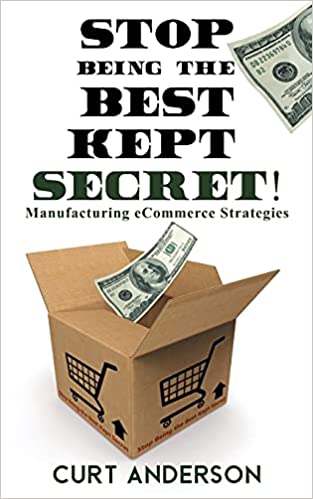
And so therefore I wrote a book, it’s called Stop Being the Best Kept Secret. And it’s just kind of a blueprint or a guide of China to help manufacturers to figure out this whole digital marketing e-commerce thing. I do a lot of webinars, workshops, trainings, working with manufacturers. That’s my jam.
Let’s give it up for Curt Anderson for sharing his scale tale. If you want more information about him, then click on the resources link in this episode’s show notes. There you’ll find out how you can buy his book, subscribe to his weekly LinkedIn Live show, and participate in his e-commerce events.
Well, Alicia, thank you. I’ll tell you, you are an incredible inspiration to me. You mean a ton to me.
And you mean a ton to me too, Curt.

Thank you so much for listening! If you enjoyed this episode, then subscribe to the show and leave a five-star rating and review wherever you’re listening.
Coming up next, you’ll hear how a leading contact centre expert in Europe scaled one of her client’s operations helping them reach a revenue they didn’t think was possible.
Growing and scaling a business is no small feat, but remember, Stay focused. Be encouraged. This entrepreneurial journey is a marathon and not a sprint. Keep operating as good on the inside as you look on the outside. Until then, keep operating smoothly as you work to cure your company’s back-office blues.
This episode was written, produced, and narrated by me, Alicia Butler Pierre. Audio editing by Clarence Levy III. Original score and sound design by Sabor! Music Enterprises.
This is the Business Infrastructure – Curing Back-Office Blues podcast.


